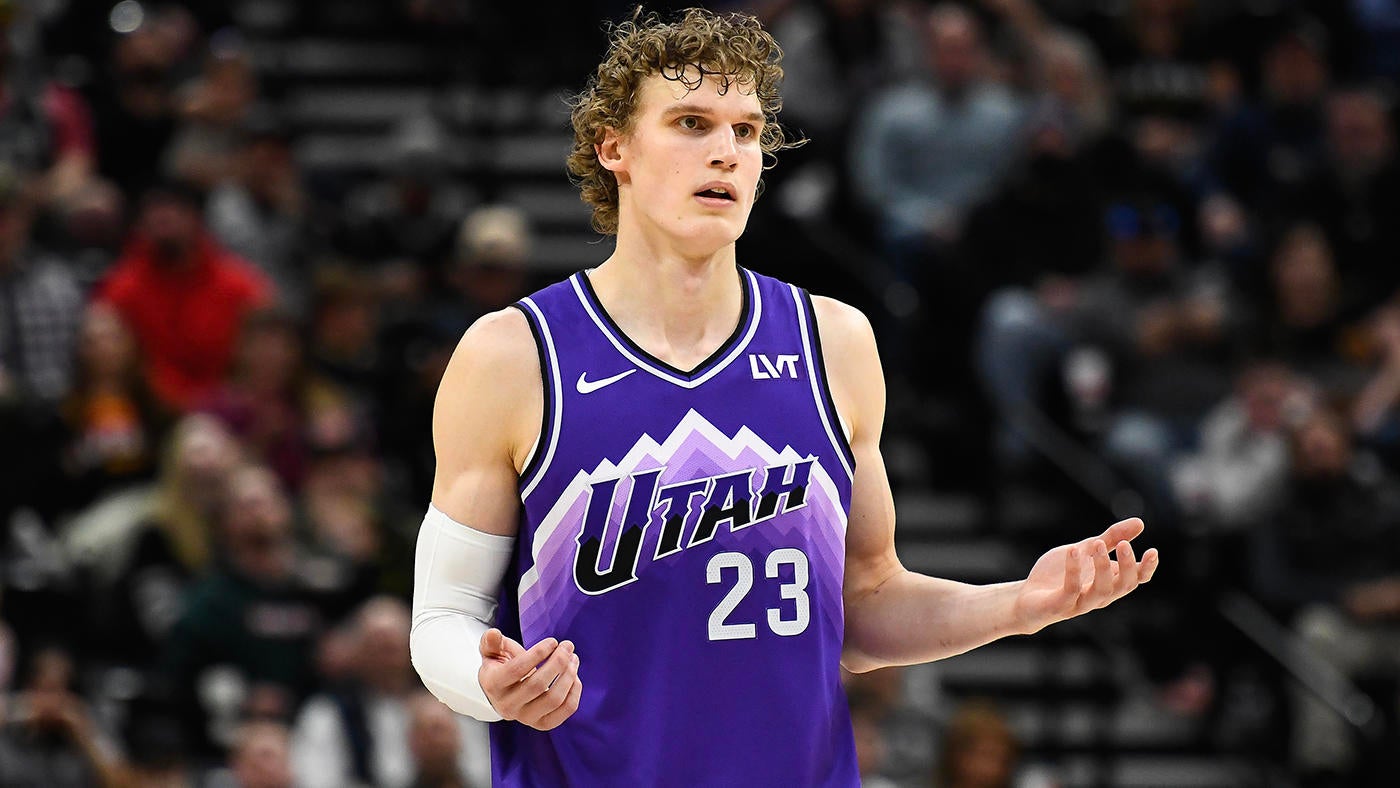
Lauri Markkanen will know where he’s starting the season, one way or another, by Aug. 6. On that date, he becomes eligible to renegotiate and extend his contract with the Utah Jazz for a substantial raise, and the timing gives him quite a bit of control over the proceedings. If he does indeed re-sign this offseason, he would not be eligible to be traded for six months. Six months after Aug. 6 is Feb. 6… which is the exact date of the 2024 trade deadline. If Markkanen wants to remain with the Jazz for at least another year, all he needs to do is wait one extra day, until Aug. 7, to re-sign in Utah.
As an impending free agent, the Jazz are more or less resigned to offering Markannen whatever terms he dictates. He’s too valuable to risk losing for nothing. If he does want to play elsewhere, he can refuse to re-sign at all. Of course, doing so would mean leaving quite a bit of money on the table. While Markkanen can re-sign with other teams, he can only renegotiate and extend with a team with the cap space to bump up his 2024-25 salary. That Jazz are the only team that can get him to market-rate this summer. If his goal is to get paid, he signs the moment he can and resolves to sort out the destination later. If Utah is not interested in paying him, well, it had better find a trade before Aug. 6, because if that date comes and goes without a deal, the Jazz lose a substantial amount of leverage in trade talks.
All of this is to say that we have something of a soft deadline for this offseason’s biggest trade target to get moved. In a few weeks, we’ll know where Markkanen is playing. Of course, the existence of that deadline also gives all parties involved a set timeline in which to negotiate, and it certainly seems as though they are using it.
The Golden State Warriors, by all accounts, are the most aggressive Markkanen suitor. The Athletic’s Shams Charania reports that the Warriors have discussed an offer around Moses Moody, multiple first-round picks, multiple pick swaps and multiple second-round picks. That’s not enough to make a deal and the Warriors probably know that. But the Jazz are reportedly asking for all of that stuff, plus Jonathan Kuminga and Brandin Podziemski. This is obviously too much, and the Jazz probably know that too.
Both sides have justifiable stances here. Golden State could credibly argue that there is no point in trading for Markkanen if they can’t keep Podziemski and Kuminga. The whole goal of making such a move would be to compete for a fifth championship while the 36-year-old Stephen Curry still can. That might be three more years. It might be one. It might even be none. Even with Markkanen they’d be far from Western Conference favorites. It’s entirely reasonable of them to believe that they cannot afford to give away good players. Their path to contending with Markkanen is cleanest if he only costs them a matching salary (which is conveniently minimal at Markkanen’s low $18 million cap figure) and an abundance of draft capital that isn’t helping them win now.
The Jazz, frankly, could care less if the Warriors win right now. The entire goal of trading for future picks belonging to a team built around a 36-year-old is to benefit when they start losing later. This is the single biggest reason they want Podziemski and Kuminga. Yes, they are good players that could help the Jazz down the line. But they are also good young players that could help the Warriors win down the line when Golden State is sending draft picks to Utah. The Jazz want picks from a depleted Warriors team, not a young, renewed one built around Markkanen, Kuminga and Podziemski in their primes. Those two players aren’t just valuable assets in isolation. They impact the value of everything else the Warriors have to trade.
So it makes sense for both sides to posture at this point. They have until Aug. 6 to compromise. Why make your real offer before then? There’s a pretty obvious middle ground here, too. If Utah wants both of Golden State’s best young players and the Warriors want to keep both, why not just resolve all of this with one of them? That answers one question but raises another: which one?
Kuminga probably has the greater upside among the two. He’s coming off of a breakout season in which he averaged 16.1 points on nearly 53% shooting. He did so in just 26.3 minutes. Scale him up to true starter minutes alone and you’re looking at an ultra-athletic 20-point scorer that could absolutely feast off of the extra space that a Curry-Markkanen duo would create. Imagine Draymond Green throwing him lobs out of the short roll in lineups featuring the two stars and a third shooter. Good luck stopping that. Kuminga’s athleticism hasn’t translated into consistent defense yet. It still easily could. The Warriors could feasibly play lineups with Curry and four like-sized defenders (Markkanen, Green, Kuminga and Andrew Wiggins) that could switch comfortably. Big wings are worth their weight in gold right now. Kuminga has a chance to become one of the league’s most valued commodities.
And yet, Charania said on SiriusXM NBA Radio on Monday that it was Podziemski, not Kuminga, that the Jazz are focused on. And, well, that makes sense. He’s a good player and a somewhat unique one. The guards aren’t supposed to rebound the way he does. He’s a crafty playmaker, and even if you’d probably rather see him shoot a few more 3’s, self-creation inside of the arc is a valuable skill and his floaters are a real weapon against drop-coverage. He profiles as something a bit closer to a good starter than the star Kuminga might max out as, but Kuminga’s range of outcomes is wider. That might not have meant as much two years ago as it does now.
Podziemski has three years left on his rookie deal. Kuminga is eligible for a rookie extension right now. Thus far, there has been no substantial reporting on his asking price. Whatever it is, it is going to outpace his actual production thus far. That has less to do with his upside than the industry standard for rookie extensions. Franz Wagner just got the max. Kuminga may not ask for that much, but he’s not going to come cheap either. Whoever pays him his next deal, whether it’s the Jazz or Warriors, will fundamentally be paying him for a player he hasn’t turned into yet.
In the grand scheme of things, that might actually be better for the Jazz. The whole purpose of trading Markkanen instead of just re-signing him is to tank. The theory here is that Markkanen, while an All-Star, is not quite good enough to be the best player on a championship contender, but because of the market they play in, the Jazz won’t be able to convince a player who has proven to be of that caliber to come through a trade or free agency. Their only path to that sort of talent is the draft, and Markkanen, for two years, has made them too good to tank properly. Kuminga would, therefore, be a somewhat natural solution to that issue. Get him now, give him all of the room he needs to blossom, add a top pick or two, and then, in a few years when Kuminga is in his prime, you’ll have both the best version of him and the top picks you got out of his growing pains.
But this again takes us back to Utah’s incentive to see the Warriors struggle. Curry is owed two more years of super-max money. Markkanen is getting the max as well. Andrew Wiggins and Draymond Green, together, more or less count as one super-max player themselves. Throw an expensive Kuminga extension into the mix and suddenly the Warriors are right back into the second apron territory they just ducked by letting Klay Thompson and Chris Paul go. To make matters worse, while the Warriors have ducked below the aprons this summer, they are still well above the luxury tax line. They could force the Jazz to take on some extra money to help them avoid the tax entirely, but that money is obviously tied to talent that they’d want to compete with this year. But ducking it would take the Warriors one year closer to resetting their repeater tax clock. Considering the revamped tax formula starting in the 2025-26 season, that’s going to be important in terms of ownership cash flow even if it doesn’t directly affect the team’s flexibility.
The Jazz want the Warriors to make difficult financial decisions in the coming years that ultimately make them worse. Kuminga is a clearer path to that outcome than Podziemski. They’d have only one year of overlap on a new Kuminga deal and the four other expensive ones they are currently paying, but there’s no guarantee that Curry would help them out by leaving money on the table in 2026 to keep this as a short-term concern. Curry has earned the right to dictate whatever price he wants. Even if he does take a pay cut, That team isn’t exactly cheap.
Again, this trade only makes sense for the Warriors if Markkanen makes them a legitimate 2024-25 contender. Is Podziemski more important than Kuminga in that pursuit? That depends on a multitude of questions we don’t have answers for yet.
Andrew Wiggins has had two down years as he has dealt with personal issues off of the court. If he’s his 2022 self again, the need for wing depth is lightened. The addition of Kyle Anderson in free agency helps on that front. The fact that Green can play both center and forward helps too. There are versions of this roster that give the bulk of the center minutes to Green, and there are versions that rely much more heavily on Trayce Jackson-Davis and Kevon Looney. The guard rotation is a bit muddier. Gary Payton II would almost certainly be in the deal as salary filler. That leaves Curry, the only sure thing of the group, along with De’Anthony Melton and Buddy Hield. Both have obvious regular-season utility. Hield was just unplayable for the majority of a playoff series that Melton missed due to injury.
The Warriors probably wouldn’t feel especially safe with those three as their only proven guards, assuming Moody is in every iteration of this deal. Maybe keeping him out is the compromise that pushes this deal across the finish line. The Warriors probably wouldn’t mind getting Jordan Clarkson or Collin Sexton back to compensate for giving up Podziemski, but they are hard-capped at the first apron and have a pretty limited amount of matching salary unless they’re including Wiggins in a deal (hey, maybe they’d do it if Kuminga is staying put). Golden State might have to bet on the buyout market to bolster their guard depth. It’s not crazy. Eight of the NBA’s most desirable teams (Suns, Timberwolves, Celtics, Bucks, Lakers, Heat, Nuggets and 76ers) are currently locked out of the majority of the buyout market by virtue of operating above the first apron. At least there wouldn’t be as much competition. Admit it: you’re at least a little curious about what Ben Simmons might look like as a Warrior after the tanking Nets fail to trade him in February.
Keeping both makes the Warriors one of the deeper teams in the NBA. Keeping neither makes them unacceptably thin. Keeping one, whichever one it turns out to be, creates questions that Golden State would have to answer on the fly. Either way, the top teams in the Western Conference (Denver, Dallas, Oklahoma City, Minnesota) are probably a hair ahead of a Warriors team that adds Markkanen and drops Podziemski or Kuminga. A small margin might be an acceptable one. The West is one giant game of rock-paper-scissors. Draw the right matchup, get the right opposing injury, and suddenly, you’re in the Western Conference finals. If P.J. Washington and Daniel Gafford can take a reigning lottery Mavericks team to the Finals, it’s not crazy to think Markkanen could have a similar effect for the Warriors.
That’s what Danny Ainge is banking on here. Historically speaking, he does not cave on asking prices in the trade market. Nobody would be surprised if he walked away from any offer that didn’t include both young Warriors. Golden State knew what it was getting into the moment it sat down at the table with him. Even if both of the young guys are off of the table, one of them is the fair concession. The Warriors and Jazz have three weeks to meet there, and they’re going to use every second of that time to try to force the other side to blink.






